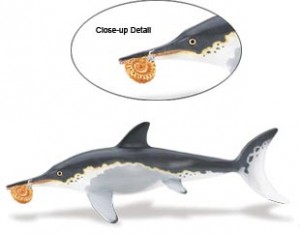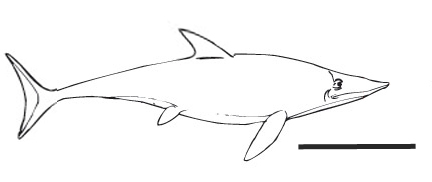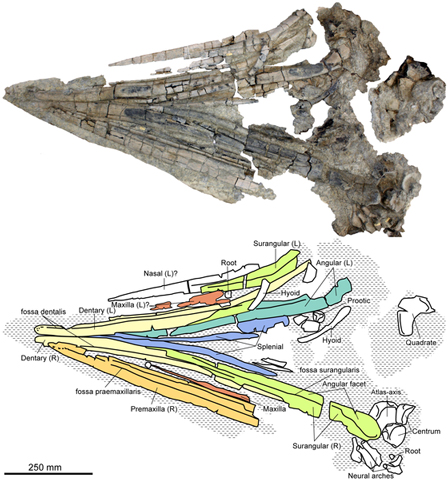New Ichthyosaur Species Swims into View
German Discovery – Challenges Ichthyosaur Extinction Theory
The partial remains of an ichthyosaur discovered by a fossil collector whilst exploring cuttings made by a road construction crew in Germany, may hold the key to shedding light on one of the mysteries surrounding the evolution of ichthyosaurs. After a careful comparison with other known ichthyosaur specimens from Germany, England and the USA, this new creature has been regarded as a new ichthyosaur species and given the name Acamptonectus densus. The name means “rigid swimmer”.
New Ichthyosaur Species
Ichthyosaurs, otherwise known as “fish-lizards” are an Order of reptiles that evolved in the Early Triassic and survived right up to near the end of the Cretaceous. Ichthyosaurs were fast-swimming, nektonic and predatory marine reptiles. With their dolphin-like bodies and with the ability to give birth to live young (viviparous), these creatures seemed to have been one of the most successful of all the marine reptile types.
A Model of a Typical Ichthyosaur
Picture credit: Everything Dinosaur
The picture (above) shows a Safari Ltd Ichthyosaurus replica, to view the rest of the models in this prehistoric animal model range: Prehistoric World Models.
Acamptonectus densus
However, scientists have identified at least three major extinctions that have affected the ichthyosaur Order. Although the fossil record is far from complete, it is believed that the ichthyosaurs were subjected to the first mass extinction around 200 million years ago as the Triassic gave way to the Jurassic. The second mass extinction took place as the Jurassic gave way to the Cretaceous around 145 million years ago, where factors such as climate change reduced the number of highly specialised ichthyosaurs surviving into the latter part of the Mesozoic. The third major extinction event for the ichthyosaur Order took place around 90 million years ago during the Late Cretaceous. The ichthyosaurs did not survive to the very end of the Mesozoic.
A Table Showing the Approximate Dates of Ichthyosaur Major Extinction Events
Table credit: Everything Dinosaur
It had been thought that the more specialised clade of ichthyosaurs known as the ophthalmosaurs, which had thrived in the Jurassic did not survive the second mass extinction event at the onset of the Cretaceous. Ichthyosaur fossils found in Cretaceous-aged strata have tended to be representative of a second clade of these “fish-lizards”, known as the platypterygians.
There had been a number of fossil finds recorded from sediments laid down in the Cretaceous that have been ascribed to the ophthalmosaur clade, but these remains have been very fragmentary, so most scientists who had studied the ichthyosaur fossil record did believe that only the platypterygians survived into the Cretaceous geological period. What caused these extinction events is still debated, but a number of other nektonic marine creatures, including other types of marine reptile also suffered major extinction events around these dates – especially at the Jurassic/Cretaceous boundary.
An Illustration of a Typical Ophthalmosaur Ichthyosaur
Picture credit: Everything Dinosaur.
The discovery of a much more complete ophthalmosaur ichthyosaur in Germany, provides the best evidence yet that this type of dolphin-like, marine reptile did survive well into the Cretaceous. The specimen, which represents an animal around three metres long has been studied by a number of ichthyosaur specialists. It is believed this marine reptile fed on fish and cephalopods.
A Race Against Time
Private fossil collector Hans-Dieter Macht discovered the specimen whilst collecting fossils at the construction site of a new main road in the Cremlingen area, (Lower Saxony, Northern Germany), in the late spring of 2005. After finding some isolated vertebrae the collector informed the director of the State Natural History Museum at Braunschweig and a formal excavation began. As the need to complete the roadway was pressing, the field team had just three days to study the site and remove any more fossilised bones.
Despite the extreme time pressure the scientists were able to find fragmentary skull material, parts of the jaws, elements from the scapular girdle, pieces of rib, vertebrae and a complete right humerus (upper arm bone).
Ichthyosaur Fossils Provide Evidence of Ophthalmosaurs Surviving into the Cretaceous
Picture credit: PLoS One/Fischer et al.
Commenting on the find, the director of the State Natural History Museum (Braunschweig), Ulrich Joger stated:
“With this, an entire extinction theory will be questioned.”
Since the discovery of these bones almost seven years ago, palaeontologists from Germany, Scotland, England and Belgium have compared the skeleton with a similar one found back in 1958 on the north-east coast of England and determined that there is fossil evidence to suggest ophthalmosaurus did indeed survive into the Cretaceous.
The scientific paper: “New Ophthalmosaurid Ichthyosaurs from the European Lower Cretaceous Demonstrate Extensive Ichthyosaur Survival across the Jurassic–Cretaceous Boundary” by Valentin Fischer, Michael W. Maisch, Darren Naish, Ralf Kosma, Jeff Liston, Ulrich Joger, Fritz J. Krüger, Judith Pardo Pérez, Jessica Tainsh and Robert M. Appleby published in PLoS One.





